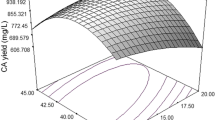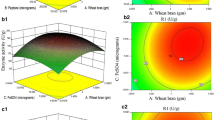Abstract
Nostoc ellipsosporum is a pharmaceutically important cyanobacteria known for the production of anti-HIV drug called cyanovirin. A five-level four factor central composite design of response surface methodology (RSM) was performed to identify the optimal level for maximum protein production. Four medium variables, PHA extract, glucose, Fe-EDTA and micronutrients, were chosen for RSM optimization study. Experimental data were analyzed by regression, and model equation was constructed. Maximum protein production was expected at the predicted optimal level of PHA extract, 2.50 % (v/v), glucose, 0.05 % (w/v), Fe-EDTA, 0.125 % (v/v) and micronutrients, 0.125 % (v/v). Validation experiment results were in good agreement with the results predicted by RSM. Results of this study showed that optimization by RSM approach improves the protein production, and also PHA extract was found to be a significant medium component for enhancing the protein synthesis.
Similar content being viewed by others
References
Botos I., Wlodawer A.: Cyanovirin-N: a sugar-binding antiviral protein with a new twist. Cell. Mol. Life Sci. 60, 277–287 (2003)
Gademan K., Portman C.: Secondary metabolites from cyanobacteria: complex structures and powerful bioactivities. Curr. Org. Chem. 12, 326–341 (2008)
Dembitsky V.M., Rezanka T.: Metabolites produced by nitrogen-fixing Nostoc _species. Folia Microbiol. 50, 363–391 (2005)
Potts, M.: Nostoc. In: Whitton, B.A.; Potts, M. (eds) The Ecology of Cyanobacteria—Their Diversity in Time and Space, pp. 465–504. Kluwer Academic Publishers, Dordrecht (2000)
DeRuyter Y.S., Fromme P.: Molecular structure of the photosynthetic apparatus. In: Herrero, A, Flores, E (eds.) The Cyanobacteria: Molecular Biology, Genomics and Evolution, pp. 217–270. Caister Academic Press, Norfolk (2008)
Boyd M.R., Gustafson K.R., McMahon J.B., Shoemaker R.H., O’Keefe B.R., Mori T., Gulakowski R.J., Wu L., Rivera M.I., Laurencot C.M., Currens M.J., Cardellina J.H., Buckheit R.W. Jr, Nara P.L., Pannell L.K., Sowder R.C., Henderson L.E.: Discovery of cyanovirin-N, a novel human immunodeficiency virus inactivating protein that binds viral surface envelope glycoprotein gp120: potential applications to microbicide development. Antimicrob. Agents Chemother. 41, 1521–1530 (1997)
Dey B., Lerner D.L., Lusso P., Boyd M.R., Elder J.H., Berger E.A.: Multiple antiviral activities of cyanovirin-N: blocking of human immunodeficiency virus type 1 gp120 interaction with CD4 and coreceptor and inhibition of diverse enveloped viruses. J. Virol. 74, 4562–4569 (2000)
Liu Z.Y., Wang G.C., Zhou B.C.: Effect of iron on growth and lipid accumulation in Chlorella vulgaris. Bioresour. Technol. 99, 4717–4722 (2008)
Anshuman S., Deepika M., Sharmila G., Muthukumaran C.: Effect of glucose and phytohaemagglutinin (PHA) rich Phaseolus vulgaris extract on growth and protein synthesis of pharmaceutically important cyanobacteria Nostoc ellipsosporum NCIM 2786. J. Genet. Eng. Biotechnol. 11, 33–37 (2013)
Chrispeels M.J., Raikhel N.V.: Lectins, lectin genes, and their role in plant defense. Plant Cell 3, 1–9 (1991)
Tanyildizi M.S., Ozer D., Elibol M.: Optimization of \({\alpha}\) -amylase production by Bacillus sp. using response surface methodology. Process Biochem. 40, 2291–2296 (2005)
Abdel-Fattah Y.R., Olama ZA.: L-Asparaginase production by Pseudomonas aeruginosa in solid-state culture: evaluation and optimization of culture conditions using factorial designs. Process Biochem. 38, 115–122 (2002)
Karthika C., Sharmila G., Muthukumaran C., Manikandan K.: Utilization of whey powder as an alternate carbon source for production of hypocholesterolemic drug by Aspergillus terreus MTCC 1281. Food Sci. Biotechnol. 22, 1335–1341 (2013)
Abhishek K.S., Mausumi M.: Optimization of lipase-catalyzed glycerolysis for mono and diglyceride production using response surface methodology. Arab. J. Sci. Eng. 39, 2463–2474 (2014)
Myers R.H., Montgomery D.C.: Response Surface Methodology, Process and Product Optimization Using Design Experiments. Wiley, New York (1995)
Sangita G., Sonam M., Sharmila G., Muthukumaran C.: Optimization of L-asparaginase production by Serratia marcescens (NCIM 2919) under solid state fermentation using coconut oil cake. Sustain. Chem. Process. 1, 9 (2013)
Lowry O.H., Rosebrough N.J., Farr A.L., Randall R.J.: Protein measurement with the folin phenol reagent. J. Biol. Chem. 193, 265–275 (1951)
Anna W.-K., Katarzyna C., Daria P., Anna D., Karol P.: Application of response surface methodology and artificial neural network methods in modelling and optimization of biosorption process. Bioresour. Technol. 160, 150–160 (2014)
Paerl H.W.: Marine plankton. In: Brian, A., Whitton, (eds.) Ecology of Cyanobacteria II. Their Diversity in Space and Time, pp. 137. Springer, Heidelberg (2012)
Fallon J.H., Seroogy K.B.: Epidermal growth factor immunoreactive material in the central nervous system: location and development. Science 224, 1107–1109 (1984)
Author information
Authors and Affiliations
Corresponding author
Rights and permissions
About this article
Cite this article
Mittal, D., Srivatsava, A., Govindasamy, S. et al. Optimization of Critical Medium Components for Protein Production by Nostoc ellipsosporum Using Response Surface Methodology. Arab J Sci Eng 40, 1875–1880 (2015). https://doi.org/10.1007/s13369-015-1706-x
Received:
Accepted:
Published:
Issue Date:
DOI: https://doi.org/10.1007/s13369-015-1706-x




